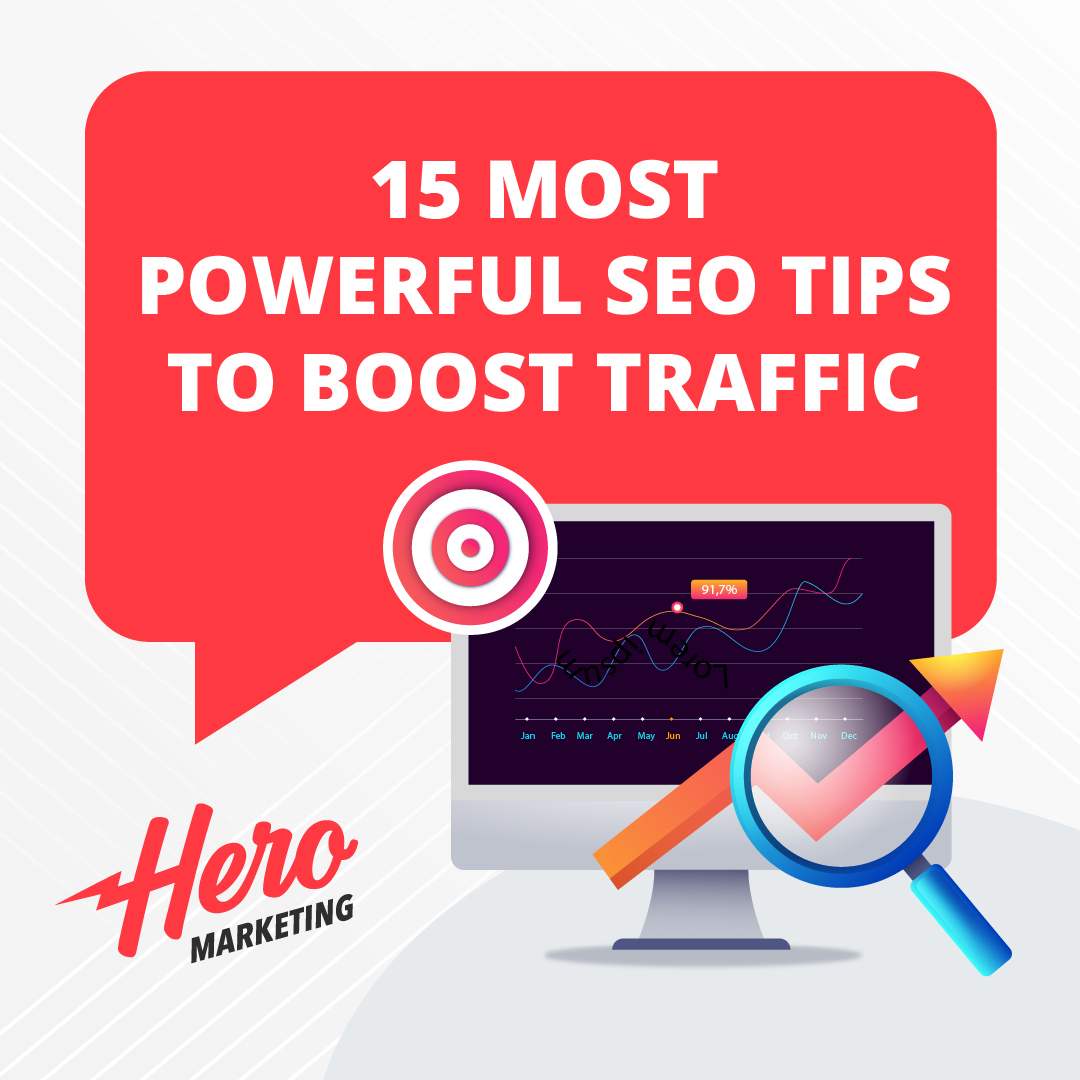Are you struggling to get your website noticed? In today’s competitive environment, strong search engine optimization (SEO) is crucial for driving traffic and improving rankings.
With countless websites vying for attention, having effective SEO strategies can set you apart from the competition. Whether you’re a beginner or have some experience, there are always new tactics to explore.
In this blog post, we will share 15 powerful SEO tips that can help boost your website’s visibility. These straightforward strategies are designed to be easy to implement, allowing you to see real results without feeling overwhelmed.
Let’s unlock your website’s potential!
1. Conduct Keyword Research
Keyword research is foundational to effective SEO. This step helps you understand what your target audience is searching for and how to position your content accordingly.
- Use Tools: Consider using free or paid tools like Google Keyword Planner, Ahrefs, or SEMrush to discover trending keywords.
- Long-Tail Keywords: Focus on long-tail keywords that are less competitive but highly relevant to your niche.
2. Optimize On-Page Elements
On-page SEO refers to the practice of optimizing individual web pages to rank higher and earn more relevant traffic. This includes:
- Title Tags: Ensure your title tag includes your primary keyword.
- Meta Descriptions: Write compelling meta descriptions that incorporate keywords and entice users to click.
For more on on-page SEO best practices, check out Moz’s Guide.
3. Create Quality Content
Content is king in the world of SEO. Your articles should be informative, engaging, and tailored to your audience’s needs.
Tips for Quality Content:
- Focus on providing value. Address common pain points that your audience faces.
- Use visuals such as images, infographics, and videos to enhance engagement.
- Ensure content is mobile-friendly. A responsive design improves user experience and SEO.
Incorporating these strategies will not only elevate your content’s quality but also encourage readers to spend more time on your webpage, signaling to search engines that your site is valuable.
4. Utilize Backlinks
Backlinks, or inbound links, are crucial for SEO as they signal to search engines that your content is authoritative and trustworthy. Here’s how to obtain backlinks:
- Guest Blogging: Contribute guest posts to relevant websites in your industry.
- Collaborations: Partner with other businesses or influencers to create valuable content and link to each other’s sites.
- Directory Listings: Submit your website to reputable directories such as Yelp or Google My Business.
Remember, quality over quantity when it comes to backlinks. A few high-quality links from trusted sources can have a more significant impact than multiple low-quality ones.
5. Optimize for Local SEO
Backlinks, or inbound links, are crucial for SEO as they signal to search engines that your content is authoritative and trustworthy. Here’s how to obtain backlinks:
- Guest Blogging: Contribute guest posts to relevant websites in your industry.
- Collaborations: Partner with other businesses or influencers to create valuable content and link to each other’s sites.
- Directory Listings: Submit your website to reputable directories such as Yelp or Google My Business.
Remember, quality over quantity when it comes to backlinks. A few high-quality links from trusted sources can have a more significant impact than multiple low-quality ones.
6. Utilize Social Media
While social media may not directly impact search rankings, it plays a significant role in brand awareness and indirectly influences SEO by driving traffic to your website.
Here’s how to leverage social media for SEO:
- Share Content: Share your blog posts and web pages on social media platforms to reach a broader audience.
- Engage with Followers: Respond to comments, initiate conversations, and engage with followers regularly.
- Utilize Hashtags: Use relevant hashtags in your posts to broaden the reach of your content.
Remember, the key is not just promoting but building genuine connections with your target audience through social media.
7. Optimize for Mobile
Mobile optimization is crucial as more people are using their phones for browsing and searching. To ensure a smooth mobile experience, consider these tips:
- Responsive Design: Use a responsive design that adjusts to different screen sizes.
- Reduce Load Time: Optimize images and use caching to reduce load time.
- Clear Navigation: Ensure your website is easy to navigate on mobile devices.
8. Monitor Site Speed
Website speed is one of the top factors that can impact user experience and search rankings. To improve site speed:
- Optimize Images: Compress images without sacrificing quality using tools like ImageOptim or Kraken.
- Minify Code: Reduce unnecessary code by minifying CSS, HTML, and JavaScript files.
- Utilize Caching: Use browser caching for quicker page loading times.
Google’s PageSpeed Insights can also provide helpful recommendations for improving site speed.
9. Utilize Schema Markup
Schema markup is code that helps search engines understand the content on a webpage better. It can improve your website’s appearance in search results and increase click-through rates.
Here are popular types of schema markup:
- Organization: Provides information about the organization, such as name, contact info, and logo.
- Product: Displays product details like price and availability.
- Review: Shows star ratings and review counts.
Implementing schema markup gives you an edge over competitors who are not utilizing it, increasing your chances of appearing in rich snippets (enhanced search result features). Check out Google’s Structured Data Markup Helper to get started.
10. Use Social Sharing Buttons
Adding social sharing buttons on your website makes it easy for readers to share your content with their followers, increasing the potential reach and visibility of your web pages. Here’s how:
- Strategic Placement: Place social sharing buttons in prominent locations, such as at the top or bottom of blog posts.
- Include Calls-to-action: Encourage users to share by adding persuasive calls-to-action alongside the buttons. For example, “Share this article with your friends and colleagues!”
11. Leverage Video Content
Video is a powerful way to engage audiences and can also improve SEO. Here’s how:
- Optimize Titles and Descriptions: Use keywords in your video titles and descriptions to increase visibility.
- Utilize Closed Captions: Including closed captions can enhance accessibility for viewers and improve search rankings.
- Embed Videos on Website: Embedding videos on web pages can keep visitors on your site longer, indicating to search engines that the content is valuable.
12. Monitor and Analyze Analytics
To see what’s working (and what isn’t), regularly monitor and analyze website analytics using tools like Google Analytics or SEMrush. These insights can help you make informed decisions about future strategies. Consider monitoring:
- Traffic Sources: Understand which channels are driving the most traffic to your website.
- Top Performing Keywords: Identify which keywords are generating the most engagement and adjust your strategy accordingly.
- Bounce Rates: Monitor bounce rates to gauge how well your content is resonating with visitors.
13. Use Alt Text for Images
Alt text (alternative text) is a description of an image that appears in place of the image if it fails to load or if a screen reader is being used. Here’s why alt text is essential:
- Enhanced Accessibility: Alt text allows visually impaired individuals to understand images on web pages.
- Improved SEO: Using relevant keywords in alt text can improve search rankings and visibility.
- Compliance with Web Standards: Alt text is a web standard that ensures equal access to information for all users.
14. Regularly Update and Refresh Content
Updating and refreshing old content can improve SEO by keeping it relevant and up-to-date. Here are some ways to refresh your content:
- Update Statistics: Keep statistics, figures, and data in blog posts current.
- Add New Information: If you’ve learned something new since publishing the post, add it in as an update.
- Improve Visuals: Replace outdated visuals with updated ones or add new ones to enhance engagement.
15. Consistency is Key
Finally, consistency is crucial for maintaining strong SEO. Continuously implementing these tips and strategies will bring results over time, but remember to stay consistent in your efforts.
Are you ready to take your SEO strategy to the next level?
Effective SEO requires a multifaceted approach that combines technical tactics with high-quality content and strategic targeting.
By following these 15 powerful SEO tips, you can boost your website’s traffic and improve its search rankings, ultimately leading to increased visibility and success online.
Remember to regularly track your progress and adjust your strategy as needed for continued growth. Here’s to unlocking the full potential of your website! Happy optimizing!
Book a call with Hero Marketing Agency today, and let us help you unlock your website’s true potential!







